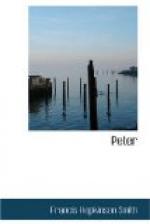But MacFarlane had already been forewarned. The engineer of the morning express, who had crossed close to the boulevard at the moment the break occurred, had leaned far out of his cab as the train thundered by at right angles to the “fill,” and with cupped hands to his mouth, had hurled this yell into the ravine:
“Water! Look out! Everything busted up above! Water! Water! Run, for God’s sake!”
The men stood irresolute, but MacFarlane sprang to instant action. Grabbing the man next him,—an Italian who understood no English— he dragged him along, shouting to the others, the crowd swarming up, throwing away their shovels in their flight until the whole posse reached a point of safety near the mouth of the tunnel.
There he turned and braced himself for the shock. He realized fully what had happened: McGowan’s ill-constructed culvert had sagged and choked; a huge basin of water had formed behind it; the retaining walls had been undermined and the whole mass was sweeping down upon him. Would there be enough of it to overflow the crest line of his own “fill” or not? If it could stand the first on-thrust there was one chance in a hundred of its safety, provided the wing-walls and the foundations of the culvert held up its arch, thus affording gradual relief until the flood should have spent its force.
It was but a question of minutes. He could already see the trees sway as the mad flood struck them, the smaller ones rebounding, the large ones toppling over. Then came a dull roar like that of a tram through a covered bridge, and then a great wall of yellow suds, boiling, curling, its surface covered with sticks, planks, shingles, floating barrels, parts of buildings, dashed itself against the smoothed earth slopes of his own “fill,” surged a third of its height, recoiled on itself, swirled furiously again, and then inch by inch rose toward the top. Should it plunge over the crest, the “fill” would melt away as a rising tide melts a sand fort, the work of months be destroyed, and his financial ruin be a certainty.
But the man who had crawled out on the shore end of the great cantilever bridge over the Ohio, and who had with his own hands practically set the last rebellious steel girder one hundred feet above the water level, had still some resources left. Grabbing a shovel from a railroad employe, he called to his men and began digging a trench on the tunnel end of the “fill” to form a temporary spillway should the top of the flood reach the crest of the road bed.
Fifty or more men sprang to his assistance with pick and shovel wherever one could stand and dig. The water had now reached within five feet of the top: the rise was slower, showing that the volume had lessened; the soakage, too, was helping, but the water still gained. The bottom of the trench, cut transversely across the road bed of the “fill,” out of which the dirt was still flying from scores of willing shovels, had reached the height of the flood line. It was wide enough and deep enough to take care of the slowly rising overflow and would relieve the pressure on the whole structure; but the danger was not there. What was to be feared was the scour on the down-stream—far side—slope of the “fill.” This also, was of loose earth: too great a gulch might mean total collapse.




